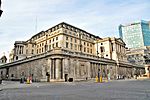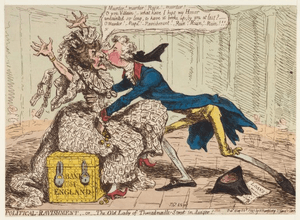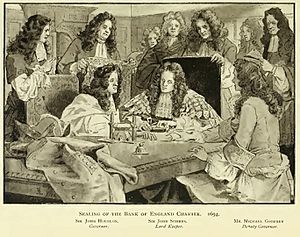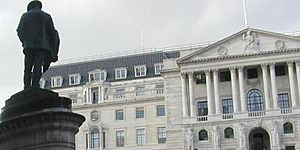Bank of England facts for kids

Seal of the Bank of England
|
|

The Bank of England building
|
|
| Headquarters | Threadneedle Street, London, England, United Kingdom |
|---|---|
| Coordinates | 51°30′51″N 0°05′19″W / 51.5142°N 0.0885°W |
| Established | 27 July 1694 |
| Ownership | Owned by HM Government through the Government Legal Department |
| Governor | Andrew Bailey (since 2020) |
| Central bank of | United Kingdom |
| Currency | Pound sterling GBP (ISO 4217) |
| Reserves | 101.59 billion USD |
| Bank rate | 0.75% |
The Bank of England is the central bank of the United Kingdom and the model on which most modern central banks have been based. Established in 1694 to act as the English Government's banker, and still one of the bankers for the Government of the United Kingdom, it is the world's eighth-oldest bank. It was privately owned by stockholders from its foundation in 1694 until it was nationalised in 1946 by the Attlee ministry.
The Bank became an independent public organisation in 1998, wholly owned by the Treasury Solicitor on behalf of the government, but with independence in setting monetary policy.
The Bank is one of eight banks authorised to issue banknotes in the United Kingdom, has a monopoly on the issue of banknotes in England and Wales and regulates the issue of banknotes by commercial banks in Scotland and Northern Ireland.
The Bank's Monetary Policy Committee has a devolved responsibility for managing monetary policy. The Treasury has reserve powers to give orders to the committee "if they are required in the public interest and by extreme economic circumstances", but such orders must be endorsed by Parliament within 28 days. The Bank's Financial Policy Committee held its first meeting in June 2011 as a macroprudential regulator to oversee regulation of the UK's financial sector.
The Bank's headquarters have been in London's main financial district, the City of London, on Threadneedle Street, since 1734. It is sometimes known as The Old Lady of Threadneedle Street, a name taken from a satirical cartoon by James Gillray in 1797. The road junction outside is known as Bank junction.
As a regulator and central bank, the Bank of England has not offered consumer banking services for many years, but it still does manage some public-facing services such as exchanging superseded bank notes. Until 2016 the bank provided personal banking services as a privilege for employees.
Contents
History
Founding
England's crushing defeat by France, the dominant naval power, in naval engagements culminating in the 1690 Battle of Beachy Head, became the catalyst for England's rebuilding itself as a global power. England had no choice but to build a powerful navy. No public funds were available, and the credit of William III's government was so low in London that it was impossible for it to borrow the £1,200,000 (at 8% p.a.) that the government wanted.
To induce subscription to the loan, the subscribers were to be incorporated by the name of the Governor and Company of the Bank of England. The Bank was given exclusive possession of the government's balances, and was the only limited-liability corporation allowed to issue bank notes. The lenders would give the government cash (bullion) and issue notes against the government bonds, which can be lent again. The £1.2m was raised in 12 days; half of this was used to rebuild the navy.
As a side effect, the huge industrial effort needed, including establishing ironworks to make more nails and advances in agriculture feeding the quadrupled strength of the navy, started to transform the economy. This helped the new Kingdom of Great Britain – England and Scotland were formally united in 1707 – to become powerful. The power of the navy made Britain the dominant world power in the late 18th and early 19th centuries.
The establishment of the bank was devised by Charles Montagu, 1st Earl of Halifax, in 1694. The plan of 1691, which had been proposed by William Paterson three years before, had not then been acted upon. (It is worth noting though, that 28 years earlier, in 1636, Financier to the king Philip Burlamachi had proposed exactly the same idea in a letter addressed to Sir Francis Windebank.) He proposed a loan of £1.2m to the government; in return the subscribers would be incorporated as The Governor and Company of the Bank of England with long-term banking privileges including the issue of notes. The Royal Charter was granted on 27 July through the passage of the Tonnage Act 1694. Public finances were in so dire a condition at the time that the terms of the loan were that it was to be serviced at a rate of 8% per annum, and there was also a service charge of £4,000 per annum for the management of the loan. The first governor was Sir John Houblon, who is depicted in the £50 note issued in 1994. The charter was renewed in 1742, 1764, and 1781.
18th century

The Bank's original home was in Walbrook, a street in the City of London, where during reconstruction in 1954 archaeologists found the remains of a Roman temple of Mithras (Mithras is – rather fittingly – said to have been worshipped as, amongst other things, the God of Contracts); the Mithraeum ruins are perhaps the most famous of all 20th-century Roman discoveries in the City of London and can be viewed by the public.
The Bank moved to its current location in Threadneedle Street in 1734, and thereafter slowly acquired neighbouring land to create the edifice seen today. Sir Herbert Baker's rebuilding of the Bank, demolishing most of Sir John Soane's earlier building, was described by architectural historian Nikolaus Pevsner as "the greatest architectural crime, in the City of London, of the twentieth century".
When the idea and reality of the National Debt came about during the 18th century, this was also managed by the Bank. By the charter renewal in 1781 it was also the bankers' bank – keeping enough gold to pay its notes on demand until 26 February 1797 when war had so diminished gold reserves that - following an invasion scare caused by the Battle of Fishguard days earlier - the government prohibited the Bank from paying out in gold by the passing of the Bank Restriction Act 1797. This prohibition lasted until 1821.
19th century
The 1844 Bank Charter Act tied the issue of notes to the gold reserves and gave the Bank sole rights with regard to the issue of banknotes. Private banks that had previously had that right retained it, provided that their headquarters were outside London and that they deposited security against the notes that they issued. A few English banks continued to issue their own notes until the last of them was taken over in the 1930s. Scottish and Northern Irish private banks still have that right.
The bank acted as lender of last resort for the first time in the panic of 1866.
The last private bank in England to issue its own notes was Thomas Fox's Fox, Fowler and Company bank in Wellington, which rapidly expanded, until it merged with Lloyds Bank in 1927. They were legal tender until 1964. There are nine notes left in circulation; one is housed at Tone Dale House Wellington.
20th century
Britain remained on the gold standard until 1931 when the gold and foreign exchange reserves were transferred to the Treasury, but they continued to be managed by the Bank.
During the governorship of Montagu Norman, from 1920–44, the Bank made deliberate efforts to move away from commercial banking and become a central bank. In 1946, shortly after the end of Norman's tenure, the bank was nationalised by the Labour government.
After 1945 the Bank pursued the multiple goals of Keynesian economics, especially "easy money" and low interest rates to support aggregate demand. It tried to keep a fixed exchange rate, and attempted to deal with inflation and sterling weakness by credit and exchange controls.
In 1977, the Bank set up a wholly owned subsidiary called Bank of England Nominees Limited (BOEN), a private limited company, with two of its hundred £1 shares issued. According to its Memorandum & Articles of Association, its objectives are: "To act as Nominee or agent or attorney either solely or jointly with others, for any person or persons, partnership, company, corporation, government, state, organisation, sovereign, province, authority, or public body, or any group or association of them...." Bank of England Nominees Limited was granted an exemption by Edmund Dell, Secretary of State for Trade, from the disclosure requirements under Section 27(9) of the Companies Act 1976, because "it was considered undesirable that the disclosure requirements should apply to certain categories of shareholders." The Bank of England is also protected by its Royal Charter status, and the Official Secrets Act.
In 1981 the reserve requirement for banks to hold a minimum fixed proportion of their deposits as reserves at the Bank of England was abolished: see reserve requirement for more details. The contemporary transition from Keynesian economics to Chicago economics was analysed by Kaldor in The Scourge of Monetarism
On 6 May 1997, following the 1997 general election which brought a Labour government to power for the first time since 1979, it was announced by the Chancellor of the Exchequer, Gordon Brown, that the Bank would be granted operational independence over monetary policy. Under the terms of the Bank of England Act 1998 (which came into force on 1 June 1998), the Bank's Monetary Policy Committee was given sole responsibility for setting interest rates to meet the Government's Retail Prices Index (RPI) inflation target of 2.5%. The target has changed to 2% since the Consumer Price Index (CPI) replaced the Retail Prices Index as the Treasury's inflation index. If inflation overshoots or undershoots the target by more than 1%, the Governor has to write a letter to the Chancellor of the Exchequer explaining why, and how he will remedy the situation.
The success of inflation targeting in the United Kingdom has been attributed to the Bank's focus on transparency. The Bank of England has been a leader in producing innovative ways of communicating information to the public, especially through its Inflation Report, which have been emulated by many other central banks.
Independent central banks that adopt an inflation target are known as Friedmanite central banks. Inflation targets combined with central bank independence have been characterised as a "starve the beast" strategy creating a lack of money in the public sector. This change in Labour's politics was described by Sidelsky in The Return of the Master as a mistake and as an adoption of the Rational Expectations Hypothesis as promulgated by Walters
The handing over of monetary policy to the Bank had been a key plank of the Liberal Democrats' economic policy since the 1992 general election. Conservative MP Nicholas Budgen had also proposed this as a private member's bill in 1996, but the bill failed as it had the support of neither the government nor the opposition.
21st century
Mark Carney assumed the post of Governor of the Bank of England on 1 July 2013. He succeeded Mervyn King, who took over on 30 June 2003. Carney, a Canadian, will serve an initial five-year term rather than the typical eight, and will seek UK citizenship. He is the first non-British citizen to hold the post. As of January 2014, the Bank also has four Deputy Governors.
Functions of the Bank
There are two main areas which are tackled by the Bank to ensure it carries out these functions efficiently:

Monetary stability
NOTE: It is important to note that "monetary" and "financial" are synonyms.
Stable prices and confidence in the currency are the two main criteria for monetary stability. Stable prices are maintained by seeking to ensure that price increases meet the Government's inflation target. The Bank aims to meet this target by adjusting the base interest rate, which is decided by the Monetary Policy Committee, and through its communications strategy, such as publishing yield curves.
- Maintaining financial stability involves protecting against threats to the whole financial system. Threats are detected by the Bank's surveillance and market intelligence functions. The threats are then dealt with through financial and other operations, both at home and abroad. In exceptional circumstances, the Bank may act as the lender of last resort by extending credit when no other institution will.
The Bank works together with other institutions to secure both monetary and financial stability, including:
- HM Treasury, the Government department responsible for financial and economic policy; and
- Other central banks and international organisations, with the aim of improving the international financial system.
The 1997 Memorandum of Understanding describes the terms under which the Bank, the Treasury and the FSA work toward the common aim of increased financial stability. In 2010 the incoming Chancellor announced his intention to merge the FSA back into the Bank. As of 2012, the current director for financial stability is Andy Haldane.
The Bank acts as the government's banker, and it maintains the government's Consolidated Fund account. It also manages the country's foreign exchange and gold reserves. The Bank also acts as the bankers' bank, especially in its capacity as a lender of last resort.
The Bank has a monopoly on the issue of banknotes in England and Wales. Scottish and Northern Irish banks retain the right to issue their own banknotes, but they must be backed one for one with deposits at the Bank, excepting a few million pounds representing the value of notes they had in circulation in 1845. The Bank decided to sell its banknote printing operations to De La Rue in December 2002, under the advice of Close Brothers Corporate Finance Ltd.
Since 1998, the Monetary Policy Committee (MPC) has had the responsibility for setting the official interest rate. However, with the decision to grant the Bank operational independence, responsibility for government debt management was transferred in 1998 to the new Debt Management Office, which also took over government cash management in 2000. Computershare took over as the registrar for UK Government bonds (gilt-edged securities or gilts) from the Bank at the end of 2004.
The Bank used to be responsible for the regulation and supervision of the banking and insurance industries. This responsibility was transferred to the Financial Services Authority in June 1998, but after the financial crises in 2008 new banking legislation transferred the responsibility for regulation and supervision of the banking and insurance industries back to the Bank.
In 2011 the interim Financial Policy Committee (FPC) was created as a mirror committee to the MPC to spearhead the Bank's new mandate on financial stability. The FPC is responsible for macro prudential regulation of all UK banks and insurance companies.
To help maintain economic stability, the Bank attempts to broaden understanding of its role, both through regular speeches and publications by senior Bank figures, a semiannual Financial Stability Report, and through a wider education strategy aimed at the general public. It maintains a free museum and runs the Target Two Point Zero competition for A-level students.
Asset purchase facility
The Bank has operated, since January 2009, an Asset Purchase Facility (APF) to buy "high-quality assets financed by the issue of Treasury bills and the DMO's cash management operations" and thereby improve liquidity in the credit markets. It has, since March 2009, also provided the mechanism by which the Bank's policy of quantitative easing (QE) is achieved, under the auspices of the MPC. Along with the managing the £200 billion of QE funds, the APF continues to operate its corporate facilities. Both are undertaken by a subsidiary company of the Bank of England, the Bank of England Asset Purchase Facility Fund Limited (BEAPFF).
Banknote issues
The Bank has issued banknotes since 1694. Notes were originally hand-written; although they were partially printed from 1725 onwards, cashiers still had to sign each note and make them payable to someone. Notes were fully printed from 1855. Until 1928 all notes were "White Notes", printed in black and with a blank reverse. In the 18th and 19th centuries White Notes were issued in £1 and £2 denominations. During the 20th century White Notes were issued in denominations between £5 and £1000.
Until the mid-19th century, commercial banks were allowed to issue their own banknotes, and notes issued by provincial banking companies were commonly in circulation. The Bank Charter Act 1844 began the process of restricting note issue to the Bank; new banks were prohibited from issuing their own banknotes and existing note-issuing banks were not permitted to expand their issue. As provincial banking companies merged to form larger banks, they lost their right to issue notes, and the English private banknote eventually disappeared, leaving the Bank with a monopoly of note issue in England and Wales. The last private bank to issue its own banknotes in England and Wales was Fox, Fowler and Company in 1921. However, the limitations of the 1844 Act only affected banks in England and Wales, and today three commercial banks in Scotland and four in Northern Ireland continue to issue their own banknotes, regulated by the Bank.
At the start of the First World War, the Currency and Bank Notes Act 1914 was passed, which granted temporary powers to HM Treasury for issuing banknotes to the values of £1 and 10/- (ten shillings). Treasury notes had full legal tender status and were not convertible into gold through the Bank; they replaced the gold coin in circulation to prevent a run on sterling and to enable raw material purchases for armament production. These notes featured an image of King George V (Bank of England notes did not begin to display an image of the monarch until 1960). The wording on each note was:
UNITED KINGDOM OF GREAT BRITAIN AND IRELAND – Currency notes are Legal Tender for the payment of any amount – Issued by the Lords Commissioners of His Majesty's Treasury under the Authority of Act of Parliament (4 & 5 Geo. V c.14).
Treasury notes were issued until 1928, when the Currency and Bank Notes Act 1928 returned note-issuing powers to the banks. The Bank of England issued notes for ten shillings and one pound for the first time on 22 November 1928.
During the Second World War the German Operation Bernhard attempted to counterfeit denominations between £5 and £50, producing 500,000 notes each month in 1943. The original plan was to parachute the money into the UK in an attempt to destabilise the British economy, but it was found more useful to use the notes to pay German agents operating throughout Europe. Although most fell into Allied hands at the end of the war, forgeries frequently appeared for years afterwards, which led banknote denominations above £5 to be removed from circulation.
In 2006, over £53 million in banknotes belonging to the Bank was stolen from a depot in Tonbridge, Kent.
Modern banknotes are printed by contract with De La Rue Currency in Loughton, Essex.
The Vault
The Bank is custodian to the official gold reserves of the United Kingdom and around 30 other countries. The vault, beneath the City of London, covers a floor space greater than that of the third-tallest building in the City, Tower 42, and needs keys that are three feet (90 cm) long to open. As of April 2016, the Bank held around 400,000 bars, which is equivalent to 5,134 tonnes of gold. These gold deposits were estimated in January 2017 to have a current market value of £161,000,000,000. These estimates suggest the vault could hold as much as 3% of the gold mined throughout human history.
Images for kids
-
Dividend Day at the Bank of England, 1770
-
Two suffragette bombs on display at the City of London Police Museum in 2019. The bomb on the left was used in an attempted bombing outside the bank on 4 April 1913, an attack that likely would have caused many casualties had it not been foiled.
See also
 In Spanish: Banco de Inglaterra para niños
In Spanish: Banco de Inglaterra para niños







